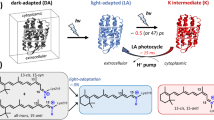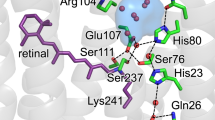Summary
In this review the proton-pumping mechanism proposed recently for bacteriorhodopsin [Chou, K. C. (1993) Journal of Protein Chemistry, 12: 337–350] is illustrated in terms of a phenomenological model. According to the model, theβ-ionone of the retinal chromophore in bacteriorhodopsin can be phenomenologically imagined as a molecular “piston”. The photon capture by bacteriorhodopsin would “pull” it up while the spontaneous decrease in potential energy would “push” it down so that it would be up and down alternately during the photocycle process. When it is pulled up, the gate of pore is open and the water channel for the proton translocation is through; when it is pushed down, the gate of pore is closed and the water channel is shut up. Such a model not only is quite consistent with experimental observations, but also provides useful insights and a different view to elucidate the protonpumping mechanism of bacteriorhodopsin. The essence of the model might be useful in investigating the mechanism of ion-channels of other membrane proteins.
Similar content being viewed by others
Abbreviations
- bR:
-
bacteriorhodopsin
- All-trans bR:
-
bacteriorhodopsin with all-trans retinal chromophore
- 13-cis bR:
-
bacteriorhodopsin with 13-cis retinal chromophore
- All-trans bundle:
-
the 7-helix bundle in the all-trans bR
- 13-cis bundle:
-
the 7-helix bundle in the 13-cis bR
- rms:
-
root-mean-square
References
Braiman MS, Mogi T, Marti T, Stern LJ, Khorana HG, Rothschild KJ (1988) Vibrational spectroscopy of bacteriorhodopsin mutants: light-driven proton transport involves protonation changes of aspartic acid residues 85, 96, and 212. Biochemistry 27: 8516–8520
Butt HJ, Fendler K, Bamburg E, Tittor J, Oesterhelt D (1989) Aspartic acids 96 and 85 play a central role in the function of bacteriorhodopsin as a proton pump. EMBO J 8: 1657–1663
Carlacci L, Schulz MW, Chou KC (1991) Geometric and energetic parameters in lysineretinal chromophores. Protein Eng 4: 885–889
Chou KC (1988) Review: Low-frequency collective motion in biomacromolecules and its biological functions. Biophys Chem 30: 3–48
Chou KC (1989) Graphic rules in steady and non-steady state enzyme kinetics. J Biol Chem 264: 12074–12079
Chou KC (1990) Review: Applications of graph theory to enzyme kinetics and protein folding kinetics: steady and non-steady-state systems. Biophys Chem 30: 1–24
Chou KC (1993) Conformational change during photocycle of bacteriorhodopsin and its proton-pumping mechanism. J Protein Chem 12: 337–350
Chou KC, Maggiora GM (1988) Biological function of low-frequency vibrations (phonons). 7. The impetus for DNA to accommodate intercalators. Br Polym 20: 143–148
Chou KC, Mao B (1988) Collective motion in DNA and its role in drug intercalation. Biopolymers 27: 1795–1815
Chou KC, Némethy G, Scheraga HA (1983) Energetic approach to the packing ofα-helices. 1. Equivalent helices. J Phys Chem 87: 2869–2881
Chou KC, Némethy G, Scheraga HA (1984) Energetic approach to the packing ofα-helices: 2. General treatment of nonequivalent and nonregular helices. J Am Chem Soc 106: 3161–3170
Chou KC, Némethy G, Rumsey S, Tuttle RW, Scheraga HA (1985) Interactions between anα-helix and aβ-sheet: energetics ofα/β packing in proteins. J Mol Biol 186: 591–609
Chou KC, Carlacci L, Maggiora GM, Parodi LA, Schulz MW (1992) An energy-based approach to packing the 7-helix bundle of bacteriorhodopsin. Protein Sci 1: 810–827
Dunker AK (1982) A proton motive force transducer and its role in proton pumps, proton engines, tobacco mosaic virus assembly and hemoglobin allosterism. J Theor Biol 97: 95–127
Engelman DM, Zaccai G (1980) Bacteriorhodopsin is an inside-out protein. Proc Natl Acad Sci USA 77: 5894–5898
Engelman DM, Henderson R, McLachlan AD, Wallace BA (1980) Path of the polypeptide in bacteriorhodopsin. Proc Natl Acad Sci USA 77: 2023–2027
Fahmy K, Siebert F, Grossjean MF, Tavan P (1989) Photoisomerization in bacteriorhodopsin studied by linear dichroism, and photoselection experiments combined with quantum chemical theoretical analysis. J Mol Struct 214: 257–288
Fodor SPA, Ames JB, Gebhard R, van der Berg EMM, Stoeckenius W, Lugtenburg J, Mathies RA (1988) Chromophore structure in bacteriorhodopsin's N intermediate: implications for the proton-pumping mechanism. Biochemistry 27: 7097–7101
Gebhard FX, Schertler FX, Lozier R, Michel H, Oesterhelt D (1991) Chromophore motion during the bacteriorhodopsin photocycle: polarized absorption spectroscopy of bacteriorhodopsin and its M-state bacteriorhodopsin crystals. EMBO J 10: 2353–2361
Gerwert K, Hess B, Soppa J, Oesterhelt D (1989) Role of aspartate-96 in proton translocation by bacteriorhodopsin. Proc Natl Acad Sci USA 86: 4943–4947
Harbison GS, Smith SO, Pardoen JA, Courtin JM, Lugtenburg J, Herzfeld J, Mathies RA, Griffin RG (1985) Solid-state13C NMR detection of a perturbed 6-s-trans chromophore in bacteriorhodopsin. Biochemistry 24: 6955–6962
Henderson R, Baldwin JM, Ceska TA, Zemlin F, Beckmann E, Downing KH (1990) Model for the structure of bacteriorhodopsin based on high-resolution electron cryo-micros-copy. J Mol Biol 213: 899–929
Heyn MP, Cherry RL, Muller U (1977) Transient and linear dichroism studies on bacteriorhodopsin: determination of the orientation of the 568 nm all-trans retinal chromophore. J Mol Biol 117: 607–620
Hilderandt P, Stockburger M (1984) Role of water in bacteriorhodopsin's chromophore: resonance raman study. Biochemistry 23: 5539–5548
Holz M, Drachev LA, Mogi T, Otto H, Kaulen AD, Heyn MP, Skulashev VP, Khorana HG (1989) Replacement of aspartic acid-96 by asparagine in bacteriorhodopsin slows both the decay of the M intermediate and the associated proton movement. Proc Natl Acad Sci USA 86: 2167–2171
Khorana HG (1988) Bacteriorhodopsin, a membrane protein that uses light to translocate protons. J Biol Chem 263: 7439–7442
Khorana HG, Gerber GE, Herlihy WC, Gray CP, Anderegg RJ, Nihei K, Biemann K (1979) Amino acid sequence of bacteriorhodopsin. Proc Natl Acad Sci USA 76: 5046–5050
Kouyama T, Nasuda-Kouyama A, Ikegami A, Mathew MK, Stoeckenius W (1988) Bacteriorhodopsin photoreaction: identification of a long-lived intermediate N (P, R350) at a high pH and its M-like photoproduct. Biochemistry 27: 5855–5863
Kozlov IA, Skulachev VP (1977) H+-adenosine triphosphatase and membrane energy coupling. Biochem Biophys Acta 463: 29–89
Lin SW, Mathies RA (1989) Orientation of the protonated retinal Schiff base group in bacteriorhodopsin from absorption linear dichroism. Biophys J 56: 653–660
Lozier RH, Bogomolni RA, Stoeckenius W (1975) Bacteriorhodopsin: a light-driven proton pump in halobacterium halobium. Biophys J 15: 955–962
Mathies RA, Lin SW, Ames JB, Pollard WT (1991) From femtoseconds to biology: mechanism of bacteriorhodopsin's light-driven proton pump. Annu Rev Biophys Biophys Chem 20: 491–518
Martel P (1992) Biophysical aspects of neutron scattering from vibrational modes of proteins. Prog Biophys Mol Biol 57: 129–179
Merz H, Zundel G (1983) Proton-transfer equilibria in phenol-carboxylate hydrogen bonds. Implications for the mechanism of light-induced proton activation in bacteriorhodopsin. Chem Phys Lett 95: 529–532
Mogi T, Stern LJ, Hackell NR, Khorana HG (1987) Bacteriorhodopsin mutants containing single tyrosine to phenylalanine substitutions are all active in proton translocation. Proc Natl Acad Sci USA 84: 5595–5599
Mogi T, Stern LJ, Marti T, Chao BH, Khorana HG (1988) Aspartic acid substitutions affect proton translocation by bacteriorhodopsin. Proc Natl Acad Sci USA 85: 4148–4152
Mogi T, Stern LJ, Chao BH, Khorana HG (1989) Structure-function studies on bacteriorhodopsin. 8. Substitutions of the membrane-embedded prolines 50, 91, and 186: the effects are determined by the substituting amino acids. J Biol Chem 264: 14192–14196
Mogi T, Thomas M, Khorana HG (1989) Structure-function studies on bacteriorhodopsin. 9. Substitutions of tryptophan rcsidues affect protein-retinal interactions in bacteriorhodopsin. J Biol Chem 264: 14197–14201
Muradin-Szweykowska M, Pardoen JA, Dobbelstein D, Van Amsterdam, LjP, Lugtenburg J (1984) Bacteriorhodopsins with chromophores modified at theβ-ionone site (formation and light-driven action of the proton pump). Eur J Biochem 140: 173–176
Nagle JF, Morowitz HJ (1978) Molecular mechanisms for proton transport in membranes. Proc Natl Acad Sci USA 75: 298–302
Oesterhelt D, Stoeckenius W (1973) Functions of a new photoreceptor membrane. Proc Natl Acad Sci USA 70: 2853–2857
Otto H, Marti T, Holz M, Mogi T, Lindau M, Khorana HG, Heyn MP (1989) Aspartic acid-96 is the internal proton donor in the reprotonation of the Schiff base of bacteriorhodopsin. Proc Natl Acad Sci USA 86: 9228–9232
Ovchinnikov YA (1982) Rhodopsin and bacteriorhodopsin: structure-function relationships. FEBS Lett 148: 179–190
Ovchinnikov YA, Abdulaev NG, Feigina MY, Kiselev AV, Lobanov NA (1979) The structural basis of the functioning of bacteriorhodopsin: an overview. FEBS Lett 100: 219–224
Popot JL, Engelman DM, Gurel O, Zaccaï G (1989) Tertiary structure of bacteriorhodopsin. J Mol Biol 210: 829–847
Richardson JS, Richardson DC, Tweedy NB, Gernet KM, Quinn TP, Hecht MH, Erickson BW, Yan Y, McClain RD, Donlan MC, Surles MC (1992) Looking at proteins: representations, folding, packing, and design-Biophysical Society National Lecture, 1992. Biophys J 63: 1186–1209
Rothschild KL (1992) FTIR difference spectroscopy of bacteriorhodopsin: toward a molecular model. J Bioenerg Biomembr 24: 147–167
Schulton K, Tavan P (1978) A mechanism for the light-driven proton pump of Halobacterium halobium. Nature 272: 85–86
Stoeckenius W, Lozier RH, Bogomolni RA (1979) Bacteriorhodopsin and the purple membrane of halobacteria. Biochim Biophys Acta 505: 215–278
Tittor J, Soell C, Oesterhelt D, Butt HJ, Bamburg E (1989) A defective proton pump, point-mutated bacteriorhodopsin Asp96 → Asn is fully reactivated by azide. EMBO J 8: 3477–3482
White ST (1992) Jane S. Richardson: Biophysical society national lecturer 1992 — an appreciation. Biophys J 63: 1185–1185
Author information
Authors and Affiliations
Rights and permissions
About this article
Cite this article
Chou, K.C. A molecular piston mechanism of pumping protons by bacteriorhodopsin. Amino Acids 7, 1–17 (1994). https://doi.org/10.1007/BF00808442
Received:
Accepted:
Issue Date:
DOI: https://doi.org/10.1007/BF00808442




